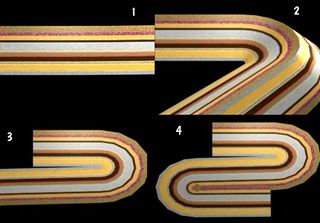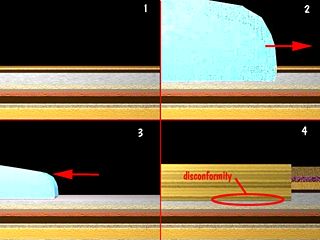Sedimentary deposition happens from the bottom up. The oldest material is at the bottom and the newest is at the top. The Grand Canyon is almost a perfect example, of this rule. As the Colorado river has cut through the strata, they lay in sequence one on top of the other layer after layer.
Law of horizontally: that layers will deposit in more of less horizontal planes when deposited from water.

Horizontal deposits can be identified and eventually an order of deposition is recorded.
The age of the deposit(s) can be calculated if the rate of deposition is known or roughly assumed.
For this assumption about ordering to be correct, there are two important assumptions:
1.) rate of sedimentation is constant
2.) they exhibit conformity.
(Conformity means that they were deposited in an uninterrupted fashion.)
Both of these assumptions are flawed!
First the rate of deposition can be shown to be highly variable depending on the weather or location of the event. Secondly There are numerous things that can break the continuity of sediment layers.
An unconformity is a substantial break in the depositional record. There are many things that can cause an unconformity, changes in sea level ( glacier formation) or tectonic activity (raising or lower of land or folding of layers). (Diagram above)
An angular unconformity happens when horizontal layers of sediment overlay angular layers.

A second type of unconformity is called a disconformity and is more difficult to detect. This type removes or stops normal deposition but does not disturb the horizontal layering.
This example shows normal deposition followed by a time of glaciation which removes some layers, and after the glacier recedes more horizontal layers are deposited. If we look further away sometimes we can find the pint where the disconformity occurred.
When a disconformity is suspected it is often necessary to find a secondary way to prove it. This can be done via fossil recognition in some cases.
A third type of unconformity is called a nonconformity, and happens when sedimentary rock overlays igneous or metamorphic rock.
It is possible to create a record of sedimentary layers that are the same or can be fitted into the layers from other areas. This creates a correlation set that can be used to time many non-connected areas. If tops from one area can be matched with bottoms from others, then a continuous set of layers can be indexed.
Besides the direct relationship, the fossils in the various layers can also be indexed. If there is a specific fossil that always identifies one layer, then it is called an Indexing Fossil.
| NEXT | TOC | PREV |